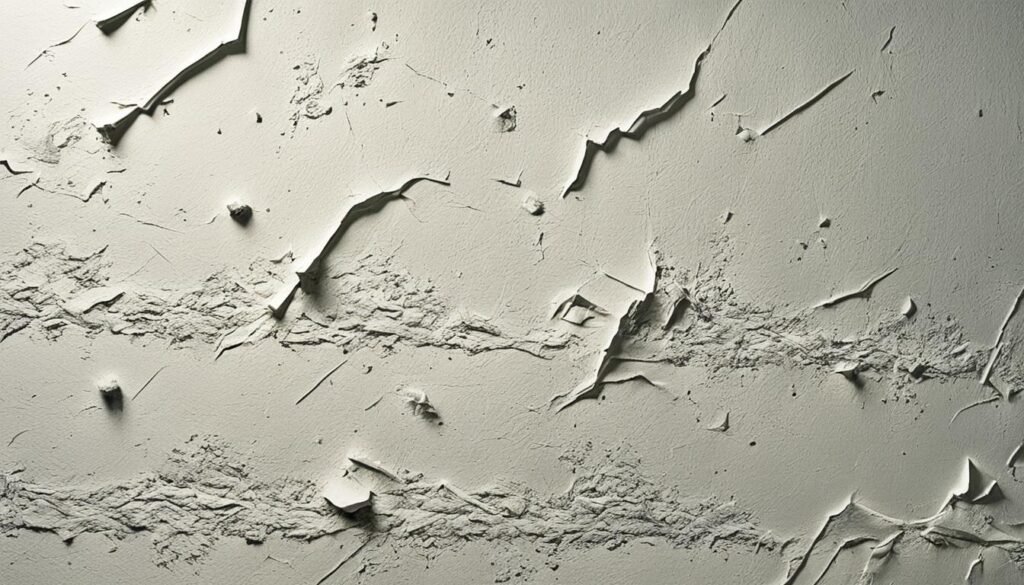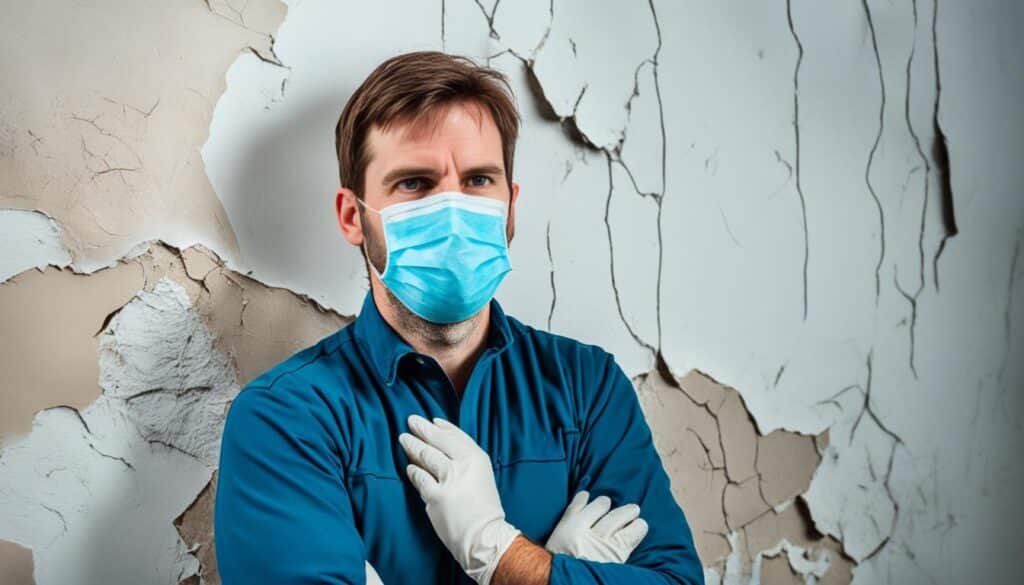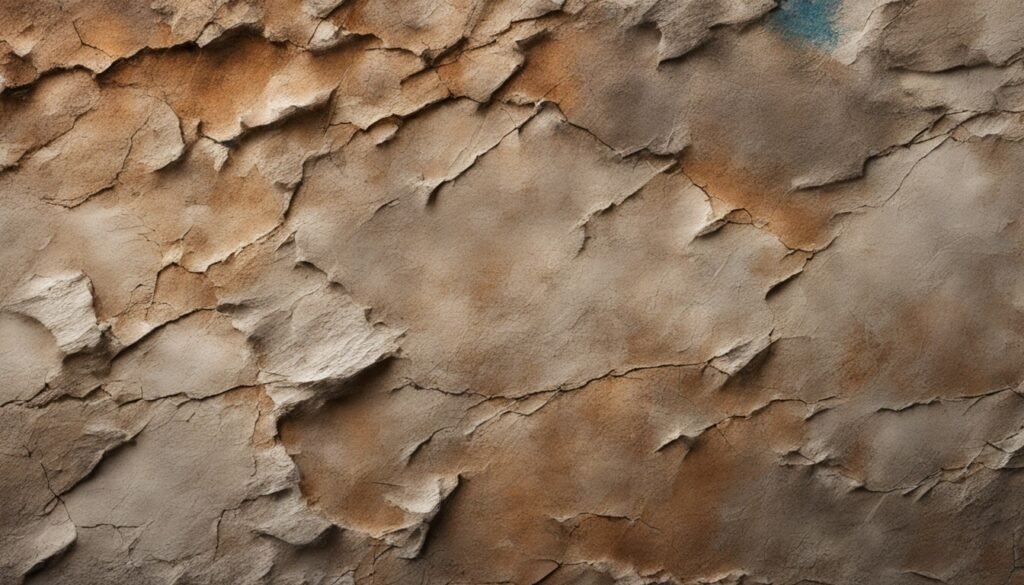If you own an older home, you might have seen horsehair plaster. This plaster has been around for centuries. But, it can be risky if it has asbestos or other harmful stuff. When thinking about fixing up your old home, knowing about these risks is key.
Key Takeaways
- Horsehair plaster is a traditional building material used before the mid-20th century.
- It is composed of a mixture of lime, sand, water, and horsehair, which provides strength and prevents cracking.
- Horsehair plaster may contain asbestos or other hazardous materials, posing risks during renovations.
- Homeowners should be aware of the potential dangers and take appropriate precautions when working with or removing horsehair plaster.
- Asbestos testing and proper removal procedures are crucial to ensure the safety of homeowners and workers.
What is Horsehair Plaster?
Horsehair plaster has been a key building material for centuries. It’s a mix of lime, sand, water, and horsehair. This historic plaster is known for its strength and ability to be shaped into complex designs.
Composition and Purpose
The traditional plaster mix includes important ingredients:
- Lime: This gives the plaster its binding and setting properties.
- Sand: It adds strength and makes the mixture thicker.
- Water: This lets the ingredients mix and stick to surfaces.
- Horsehair: It acts as a reinforcing agent, keeping the plaster strong and preventing cracks.
The plaster reinforcement from horsehair made this plaster stand out. Horsehair, from horses’ manes and tails, was crucial for a strong and lasting wall finish.
“Horsehair plaster was valued for its strength, sound-dampening properties, and ability to be molded into intricate shapes and designs.”
| Ingredient | Function |
|---|---|
| Lime | Provides the binding and setting properties of the plaster |
| Sand | Adds strength and volume to the mixture |
| Water | Allows the ingredients to be mixed and applied to surfaces |
| Horsehair | Serves as a reinforcing agent, helping to bind the plaster together and prevent cracking |
Potential Dangers of Horsehair Plaster
Horsehair plaster is not dangerous on its own. But, it can be risky if it has asbestos or other harmful stuff. In the old days, some builders added asbestos to plaster to make it stronger and better at stopping fires and absorbing sounds. This kind of asbestos-containing plaster was often used in the mid-20th century.
Asbestos Contamination
Being around asbestos fibers can lead to serious health problems like lung cancer and mesothelioma. Homeowners should test their plaster walls for asbestos before starting any renovations or removal work. This is key to keeping the homeowner and workers safe.
“Asbestos-containing plaster can pose a serious threat to human health, and it’s essential that homeowners take the necessary precautions to protect themselves and their families.” – Expert in Plaster Renovations
If the plaster has asbestos, it’s crucial to remove it safely. Trying to take out asbestos-contaminated plaster without the right skills and gear can spread harmful fibers. This risks the health of everyone nearby.

Knowing the risks of horsehair plaster helps homeowners make smart choices for their home updates. It ensures they and their families stay safe.
is horsehair plaster dangerous
Horsehair plaster can be dangerous for homeowners. Many walls with horsehair plaster are safe. But, some may have asbestos, which can release harmful fibers when disturbed.
Horsehair plaster might also have anthrax spores, which are very dangerous. Anthrax is a rare but deadly disease. It comes from infected animals or their products.
Homeowners thinking about horsehair plaster should be careful. They should have it tested for asbestos or anthrax spores. If it’s found, a licensed pro must remove it to keep everyone safe.

Many old homes have horsehair plaster walls. It’s key to know the risks. By being careful and getting help when needed, homeowners can stay safe.
Identifying Asbestos in Horsehair Plaster
Figuring out if your home’s horsehair plaster has asbestos is tough. Generally, plaster with darker horsehair fibers is less likely to have asbestos. But, lighter-colored fibers might mean it does. The best way to know for sure is to have a pro test a plaster sample.
Looking at the plaster can give you some hints, but it’s not a sure way to find asbestos. Watch for signs like crumbling, cracks, or water damage. These could mean asbestos fibers are getting loose. If you think your plaster might have asbestos, it’s key to get it checked by an expert.
| Characteristic | Likelihood of Asbestos |
|---|---|
| Darker Horsehair Fibers | Less Likely |
| Lighter Horsehair Fibers | More Likely |
| Visible Damage (Crumbling, Cracks, Water Damage) | Increased Risk of Asbestos Release |
Homeowners need to know that asbestos in horsehair plaster is a big health risk if it gets disturbed or damaged. It’s important to identify it correctly and test it with a pro. This ensures your home and family stay safe.
“The only way to be certain about the presence of asbestos in your plaster is to have it professionally tested.”
Safe Handling and Removal
Handling and removing horsehair plaster safely is key, especially if it has asbestos. Homeowners need to be very careful to avoid harmful plaster dust and fibers during removal.
First, don’t brush, sweep, or sand the plaster. These actions can spread dangerous particles. Instead, remove the plaster with gloved hands or a hammer into big chunks. Then, dispose of them safely.
If you think the plaster might have asbestos, get a pro asbestos removal expert. They have the right training and gear for safe and proper removal. This keeps homeowners and the environment safe.
By sticking to these safety protocols, homeowners can protect themselves against plaster dust hazards. They ensure the safe removal of horsehair plaster from their homes.
Alternatives to Horsehair Plaster
Traditional horsehair plaster is less used today. Homeowners now have many other options for finishing walls and ceilings. Drywall, also known as sheetrock or gypsum board, is a top choice for new buildings and updates.
But, for those wanting to keep their homes looking historic, modern plaster is a great option. These plasters mimic the look and feel of old horsehair plaster. They offer similar beauty and performance but are safer.
Advantages of Modern Plaster Systems
- Durable and long-lasting, with a smooth, seamless finish
- Excellent sound-proofing and insulation properties
- Water and moisture resistance, making them suitable for both interior and exterior applications
- Fire-resistant, offering an added layer of safety for historic home renovations
For homeowners aiming to keep their historic homes looking authentic, modern plaster is a strong choice. It brings the beauty and performance of traditional horsehair plaster without the risks.
“Solid plastering, an alternative to horsehair plaster, is highlighted as a durable and versatile option for both interior and exterior applications, offering benefits such as sound-proofing, water and moisture resistance, fire-resistance, and longevity.”
| Feature | Drywall | Modern Plaster |
|---|---|---|
| Durability | Moderate | High |
| Sound Insulation | Fair | Excellent |
| Water Resistance | Limited | Excellent |
| Fire Resistance | Fair | Excellent |
Conclusion
Horsehair plaster from the past can be risky, especially if it has asbestos or other harmful stuff. This material was common back then, but now, we must handle it carefully to keep us safe.
When fixing up an old house with historic plaster, getting it checked by experts is key. If it’s not safe, they should remove it safely. Knowing the risks and being careful helps keep your home’s old charm while keeping you safe. With the right steps, you can fix up your old home with confidence.
Your safety is the most important thing. By learning and working with skilled pros, you can keep your historic home’s charm. And make sure your home is safe and healthy for your family.

